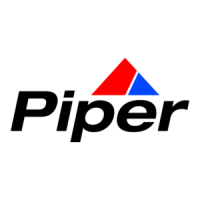
Do you have a question about the Piper PA-32R-301 SARATOGA SP and is the answer not in the manual?
| Manufacturer | Piper Aircraft |
|---|---|
| Model | PA-32R-301 Saratoga SP |
| Type | Single-engine, low-wing, retractable-gear aircraft |
| Engine | Lycoming IO-540-K1G5 |
| Horsepower | 300 hp |
| Seats | 6 |
| Max Takeoff Weight | 3, 600 lbs (1, 633 kg) |
| Propeller | Constant speed, 3-blade |
| Empty Weight | 2, 250 lbs |
| Fuel Capacity | 102 US gal (386 L) |
| Maximum Speed | 174 knots |
General information on manual preparation and GAMA Specification No. 2 compliance.
Lists serial numbers for PA-32R-301 Saratoga SP and PA-32R-301T models by year.
Provides a guide to the manual's organization by System/Chapter and Sub-System/Section.
Details FAA approved airworthiness limitations and inspections required under FAR Part 91.163.
This chapter provides instructions for conducting inspections, repair, or replacement of components.
Details inspection requirements, preflight checks, and overlimits inspection procedures.
Explains Piper Inspection programs compliance with FAA regulations and lists inspection documents.
Covers inspections required due to special conditions or incidents that arise needing immediate attention.
Shows principal airplane dimensions and leading particulars.
Presents detailed specifications for engine, propeller, fuel system, and landing gear particulars.
Provides procedures for safely jacking the airplane for servicing landing gear and other operations.
Explains procedures for longitudinal and lateral leveling of the airplane.
Details the procedure for weighing the airplane for weight and balance computations.
Provides procedures and cautions for towing the airplane with power equipment or by hand.
Details procedures for taxiing the airplane, including checks and observations.
Instructions for parking the airplane, including brake setting and control securing.
Explains the use of key locks on doors and the baggage compartment door.
Details location and identification of placards and markings on the exterior of the aircraft.
Details location and identification of placards and markings within the cabin.
Provides procedures for cleaning fuel screens, flushing tanks, and servicing the fuel system.
Provides guidance on checking engine oil level and changing the oil and filter.
Explains servicing of air-oil struts for proper oleo action, including piston tube exposure.
Provides general information on standard aircraft hardware installation and removal practices.
Details procedures for checking and calibrating torque wrenches and using extensions.
Illustrates the correct method for installing rod end bearings, including using specialized tools.
Provides a step-by-step procedure for safely removing cherrylock rivets.
Details the process of presetting flareless tube fittings before installation.
Outlines procedures and requirements for aircraft electrical bonding for maximum allowable resistance.
Describes the operation and maintenance of the cabin heating system, including defrosting.
Details the operation and components of the overhead vent system and optional blower.
Explains the installation and operation of the aircraft air conditioning system.
Provides a chart of probable causes and suggested remedies for common air conditioning system issues.
Discusses the mandatory use of manufacturer-specific service literature for AFCS equipment.
Lists manufacturers of Autopilot/Flight Director systems for service direction and parts support.
Provides a listing of Piper AFCS equipment service literature, emphasizing correct identification by model name.
Contains information for performing operational checks of the Emergency Locator Transmitter (ELT).
Illustrates the Avionics Master and Emergency Switch Circuit for PA32R-301 SP/301T and PA32R-301 II HP.
Provides schematics and instructions for battery removal and installation of the Narco ELT 10.
Provides instructions for correcting difficulties in the electrical system, including component descriptions.
Details the 14-volt DC single-wire, negative ground electrical system and its components.
Covers troubleshooting of the alternator system, including causes and remedies for zero output.
Details procedures for rigging and adjusting pilot seat lock and release mechanisms.
Includes troubleshooting for lost motion, resistance, and synchronization issues in aileron controls.
Covers troubleshooting for rudder pedals, control travel, and trim control knob issues.
Details troubleshooting for lost motion, resistance, and incorrect travel in stabilator controls.
Explains flap operating systems, including manual and electrically operated flap controls.
Provides instructions for inspection, repair, handling, and storage of aluminum and molded fuel cells.
Details procedures for fuel selector valve and filter maintenance, cleaning, and installation.
Covers general information, description, operation, and troubleshooting of the main landing gear system.
Provides procedures for removal, cleaning, inspection, repair, and installation of the nose gear oleo strut.
Details inspection, assembly, and installation of main and nose wheel assemblies, including brake systems.
Describes pneumatic deice system operation and troubleshooting for airfoil boots.
Covers removal and installation of the heated windshield panel.
Details deicer system operational checks, troubleshooting, and component repair procedures.
Provides general information on the instrument air system, including pitot and static air sources.
Describes the pitot air system, static air system, and alternate static source.
Provides a guide for typical removal and installation of instruments mounted on the face panel.
Details the procedure for removing and replacing instruments mounted in a cluster on the instrument panel.
Describes the gyro horizon instrument, its operation, and markings for bank degrees.
Explains the directional gyro as a flight instrument and its magnetic compass dependency.
Describes the magnetic compass as a self-contained instrument and its associated lighting circuit.
Provides supplemental information for servicing oxygen systems, recommending approved shop for major repairs.
Describes fixed and portable oxygen systems, including components and their functions.
Lists troubles, probable causes, and remedies for the oxygen system.
Explains the vacuum system's components and provides general maintenance information.
Details the vacuum system's operation, including the dry vacuum pump, regulator, and filter.
Lists troubles, probable causes, and suggested remedies for the vacuum system.
Describes switches as rocker type and circuit breakers as pushbutton type with manual reset.
Provides instructions for removing switches from the instrument panel.
Details the process for removing lighted rocker switches from the instrument panel.
Explains that the aircraft is all metal semi-monocoque with removable tips and access panels.
Outlines structural repair methods in accordance with FAA Advisory Circular 43-13-1A.
Describes methods for repairing fiberglass structures, including blisters and minor damages.
Details procedures for repairing fiberglass fractures and holes using patches.
Provides procedures for field repairs to thermoplastic items using various materials and tools.
Covers removal, installation, and adjustment of the cabin door and its latch mechanism.
Provides procedures for removal, installation, and repair of the baggage door and its hinge.
Details removal, installation, and adjustment of the baggage door lock assembly.
Covers removal, installation, and checking free play in the stabilator trim tab and aileron.
Provides steps for balancing the stabilator, including using a balancing fixture and determining static balance.
Details removal, replacement, and balancing procedures for the rudder.
Explains how to balance the rudder, including using a balancing fixture and checking limits.
Describes single pane side windows and provides removal/installation instructions.
Details removal and installation procedures for single pane side windows.
Covers inspection and maintenance of auxiliary structures like wing tips.
Covers removal, installation, and repair of wing tips.
Details procedures for attaching fittings to the wing and fuselage.
Covers removal, installation, and checking of ailerons and flaps.
Explains control cable inspection, removal, installation, rigging, and adjustment of ailerons.
Details flap operating systems, including manual and electrically operated flap controls.
Lists procedures for propeller removal, cleaning, inspection, repair, and installation.
Provides procedures for propeller maintenance, including typical nicks and removal methods.
Lists specifications for 2-blade propellers, including hub model, diameter, and blade angle.
Details how to check for oil leaks, clean spinner and hub, inspect parts for damage, and repair blades.
Explains procedures for removing, installing, rigging, and adjusting the propeller governor.
Details the removal, installation, rigging, and adjustment of the propeller governor.
Provides general suggestions for working on the power plant, including proper reinstallation and assembly.
Provides procedures for engine removal, including electrical and mechanical disconnections.
Details the step-by-step procedure for removing the engine from the aircraft.
Provides detailed steps for removing the engine from the PA-32R-301T aircraft.
Outlines the procedure for installing the engine onto its mounting points.
Provides instructions for installing the engine, including electrical and mechanical connections.
Covers removal, installation, cleaning, inspection, and repair of engine cowlings.
Details the 14V bus bar, circuit breakers, and power supply connections for various systems.
Covers magneto inspection, including lead terminals, harness outlet, and contact springs.
Provides step-by-step procedures for magneto installation and timing relative to the engine.
Details how to remove the impulse coupling from the armature shaft, emphasizing careful handling.
Covers inspection, cleaning, installation, and testing of spark plugs.
Provides procedures for removal and installation of ignition switches.
Describes the manifold pressure gauge, its operation, and troubleshooting common issues.
Details the oil temperature indicator, including its location and troubleshooting common issues.
Explains the function of the EGT gauge for selecting fuel-air mixture and procedures for removal.
Provides information for general maintenance of the entire exhaust system, including inspection procedures.
Details the 100-hour inspection requirements for the exhaust system, including muffler and tailpipe.
Covers installation and servicing of the oil cooler and the oil pressure sensor.
Details the function and troubleshooting of the oil pressure sensor and gauge.
Provides procedures for maintenance of the starting system, including battery checks and wiring inspection.
Details the process for removing the starting motor from the engine for cleaning and repair.
Provides step-by-step instructions for disassembling the starting motor, including brushes, armature, and field coils.
Outlines procedures for bench testing the starting motor, including no-load and stall torque tests.
Explains the turbocharger system, its components, and troubleshooting common issues.
Details the procedure for priming the turbocharger lubrication system before unit mounting.
Covers the removal and installation procedures for the turbocharger assembly.
Provides steps for removing the turbocharger compressor and turbine assembly.
Details the process of positioning and securing the turbocharger assembly.
Covers removal, installation, and adjustment procedures for the exhaust wastegate assembly.
Indexes electrical schematics by figure number, grid number, and effectivity.
Provides torque values for various fittings and hardware, with cautionary notes.
Continues torque requirements, including self-locking fasteners and recommendations for Lycoming engines.
Lists recommended nut torques for various steel and aluminum fasteners.
Continues the list of recommended nut torques for fine thread series.
Provides conversion tables for inches to millimeters and Fahrenheit to Celsius.
Presents Centigrade-Fahrenheit conversion tables.
Provides metric equivalents for drill sizes and other units.
Lists consumable materials for repairs, including ABS-Solvent Cements and cleaners.
Lists consumable materials for grease, aircraft instrumentation, and gear lubrication.
Lists consumable materials for hydraulic fluid, solvents, and adhesives.
Lists consumable materials for sealants, fiberglass repairs, and hardware.
Lists consumable materials for solvents, propeller slip ring cleaning solvent, and toluol.
Lists consumable materials for silicone compound, and vinyl tape.
Provides instructions for building a tire balancer, including materials and dimensions.
Details the construction of a tire balancer using readily available materials.
Describes the use and fabrication of a tool for balancing control surfaces.
Ensures control surface is in final flight configuration for balancing, with notes on paint and free play.
Provides steps for balancing the stabilator, including using a balancing fixture and determining static balance.
Illustrates the tool and dimensions for aligning the gear back-up extender actuator.
Details the fabrication of a tool for baggage door lock removal and installation.
Provides instructions and diagrams for fabricating an aileron bellcrank rigging tool.
Details the fabrication of a rudder rigging tool, including dimensions and procedures.
Provides instructions for fabricating a tool for rigging aileron and flap controls.
Illustrates the fabrication of a stabilator rigging tool with detailed dimensions.
Describes single pane side windows and provides removal/installation instructions.
Details removal and installation procedures for single pane side windows.
Covers inspection and maintenance of auxiliary structures like wing tips.
Covers removal, installation, and repair of wing tips.
Details procedures for attaching fittings to the wing and fuselage.
Covers removal, installation, and checking of ailerons and flaps.
Explains control cable inspection, removal, installation, rigging, and adjustment of ailerons.
Details flap operating systems, including manual and electrically operated flap controls.
Lists procedures for propeller removal, cleaning, inspection, repair, and installation.
Provides procedures for propeller maintenance, including typical nicks and removal methods.
Lists specifications for 2-blade propellers, including hub model, diameter, and blade angle.
Provides specifications for 3-blade propellers, including hub model, diameter, and blade angle.
Details how to check for oil leaks, clean spinner and hub, inspect parts for damage, and repair blades.
Explains procedures for removing, installing, rigging, and adjusting the propeller governor.
Details the removal, installation, rigging, and adjustment of the propeller governor.
Provides general suggestions for working on the power plant, including proper reinstallation and assembly.
Provides procedures for engine removal, including electrical and mechanical disconnections.
Details the step-by-step procedure for removing the engine from the aircraft.
Provides detailed steps for removing the engine from the PA-32R-301T aircraft.
Outlines the procedure for installing the engine onto its mounting points.
Provides instructions for installing the engine, including electrical and mechanical connections.
Covers removal, installation, cleaning, inspection, and repair of engine cowlings.
Details the 14V bus bar, circuit breakers, and power supply connections for various systems.
Covers magneto inspection, including lead terminals, harness outlet, and contact springs.
Provides step-by-step procedures for magneto installation and timing relative to the engine.
Details how to remove the impulse coupling from the armature shaft, emphasizing careful handling.
Covers inspection, cleaning, installation, and testing of spark plugs.
Provides procedures for removal and installation of ignition switches.
Describes the manifold pressure gauge, its operation, and troubleshooting common issues.
Details the oil temperature indicator, including its location and troubleshooting common issues.
Explains the function of the EGT gauge for selecting fuel-air mixture and procedures for removal.
Provides information for general maintenance of the entire exhaust system, including inspection procedures.
Details the 100-hour inspection requirements for the exhaust system, including muffler and tailpipe.
Covers installation and servicing of the oil cooler and the oil pressure sensor.
Details the function and troubleshooting of the oil pressure sensor and gauge.
Provides procedures for maintenance of the starting system, including battery checks and wiring inspection.
Details the process for removing the starting motor from the engine for cleaning and repair.
Provides step-by-step instructions for disassembling the starting motor, including brushes, armature, and field coils.
Outlines procedures for bench testing the starting motor, including no-load and stall torque tests.
Explains the turbocharger system, its components, and troubleshooting common issues.
Details the procedure for priming the turbocharger lubrication system before unit mounting.
Covers the removal and installation procedures for the turbocharger assembly.
Provides steps for removing the turbocharger compressor and turbine assembly.
Details the process of positioning and securing the turbocharger assembly.
Covers removal, installation, and adjustment procedures for the exhaust wastegate assembly.
Indexes electrical schematics by figure number, grid number, and effectivity.
Provides torque values for various fittings and hardware, with cautionary notes.
Continues torque requirements, including self-locking fasteners and recommendations for Lycoming engines.
Lists recommended nut torques for various steel and aluminum fasteners.
Continues the list of recommended nut torques for fine thread series.
Provides conversion tables for inches to millimeters and Fahrenheit to Celsius.
Presents Centigrade-Fahrenheit conversion tables.
Provides metric equivalents for drill sizes and other units.
Lists consumable materials for repairs, including ABS-Solvent Cements and cleaners.
Lists consumable materials for grease, aircraft instrumentation, and gear lubrication.
Lists consumable materials for hydraulic fluid, solvents, and adhesives.
Lists consumable materials for sealants, fiberglass repairs, and hardware.
Lists consumable materials for solvents, propeller slip ring cleaning solvent, and toluol.
Lists consumable materials for silicone compound, and vinyl tape.
Provides instructions for building a tire balancer, including materials and dimensions.
Details the construction of a tire balancer using readily available materials.
Describes the use and fabrication of a tool for balancing control surfaces.
Ensures control surface is in final flight configuration for balancing, with notes on paint and free play.
Provides steps for balancing the stabilator, including using a balancing fixture and determining static balance.
Illustrates the tool and dimensions for aligning the gear back-up extender actuator.
Details the fabrication of a tool for baggage door lock removal and installation.
Provides instructions and diagrams for fabricating an aileron bellcrank rigging tool.
Details the fabrication of a rudder rigging tool, including dimensions and procedures.
Provides instructions for fabricating a tool for rigging aileron and flap controls.
Illustrates the fabrication of a stabilator rigging tool with detailed dimensions.
Describes single pane side windows and provides removal/installation instructions.
Details removal and installation procedures for single pane side windows.
Covers inspection and maintenance of auxiliary structures like wing tips.
Covers removal, installation, and repair of wing tips.
Details procedures for attaching fittings to the wing and fuselage.
Covers removal, installation, and checking of ailerons and flaps.
Explains control cable inspection, removal, installation, rigging, and adjustment of ailerons.
Details flap operating systems, including manual and electrically operated flap controls.
Lists procedures for propeller removal, cleaning, inspection, repair, and installation.
Provides procedures for propeller maintenance, including typical nicks and removal methods.
Lists specifications for 2-blade propellers, including hub model, diameter, and blade angle.
Provides specifications for 3-blade propellers, including hub model, diameter, and blade angle.
Details how to check for oil leaks, clean spinner and hub, inspect parts for damage, and repair blades.
Explains procedures for removing, installing, rigging, and adjusting the propeller governor.
Details the removal, installation, rigging, and adjustment of the propeller governor.
Provides general suggestions for working on the power plant, including proper reinstallation and assembly.
Provides procedures for engine removal, including electrical and mechanical disconnections.
Details the step-by-step procedure for removing the engine from the aircraft.
Provides detailed steps for removing the engine from the PA-32R-301T aircraft.
Outlines the procedure for installing the engine onto its mounting points.
Provides instructions for installing the engine, including electrical and mechanical connections.
Covers removal, installation, cleaning, inspection, and repair of engine cowlings.
Details the 14V bus bar, circuit breakers, and power supply connections for various systems.
Covers magneto inspection, including lead terminals, harness outlet, and contact springs.
Provides step-by-step procedures for magneto installation and timing relative to the engine.
Details how to remove the impulse coupling from the armature shaft, emphasizing careful handling.
Covers inspection, cleaning, installation, and testing of spark plugs.
Provides procedures for removal and installation of ignition switches.
Describes the manifold pressure gauge, its operation, and troubleshooting common issues.
Details the oil temperature indicator, including its location and troubleshooting common issues.
Explains the function of the EGT gauge for selecting fuel-air mixture and procedures for removal.
Provides information for general maintenance of the entire exhaust system, including inspection procedures.
Details the 100-hour inspection requirements for the exhaust system, including muffler and tailpipe.
Covers installation and servicing of the oil cooler and the oil pressure sensor.
Details the function and troubleshooting of the oil pressure sensor and gauge.
Provides procedures for maintenance of the starting system, including battery checks and wiring inspection.
Details the process for removing the starting motor from the engine for cleaning and repair.
Provides step-by-step instructions for disassembling the starting motor, including brushes, armature, and field coils.
Outlines procedures for bench testing the starting motor, including no-load and stall torque tests.
Explains the turbocharger system, its components, and troubleshooting common issues.
Details the procedure for priming the turbocharger lubrication system before unit mounting.
Covers the removal and installation procedures for the turbocharger assembly.
Provides steps for removing the turbocharger compressor and turbine assembly.
Details the process of positioning and securing the turbocharger assembly.
Covers removal, installation, and adjustment procedures for the exhaust wastegate assembly.
Indexes electrical schematics by figure number, grid number, and effectivity.
Provides instructions for building a tire balancer, including materials and dimensions.
Details the construction of a tire balancer using readily available materials.
Describes the use and fabrication of a tool for balancing control surfaces.
Ensures control surface is in final flight configuration for balancing, with notes on paint and free play.
Provides steps for balancing the stabilator, including using a balancing fixture and determining static balance.
Illustrates the tool and dimensions for aligning the gear back-up extender actuator.
Details the fabrication of a tool for baggage door lock removal and installation.
Provides instructions and diagrams for fabricating an aileron bellcrank rigging tool.
Details the fabrication of a rudder rigging tool, including dimensions and procedures.
Provides instructions for fabricating a tool for rigging aileron and flap controls.
Illustrates the fabrication of a stabilator rigging tool with detailed dimensions.

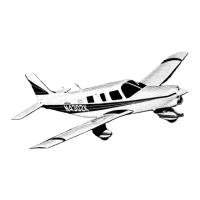





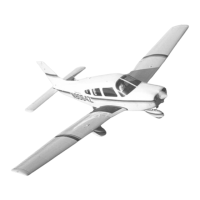
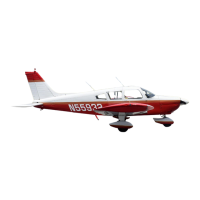


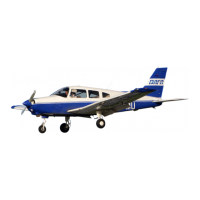
